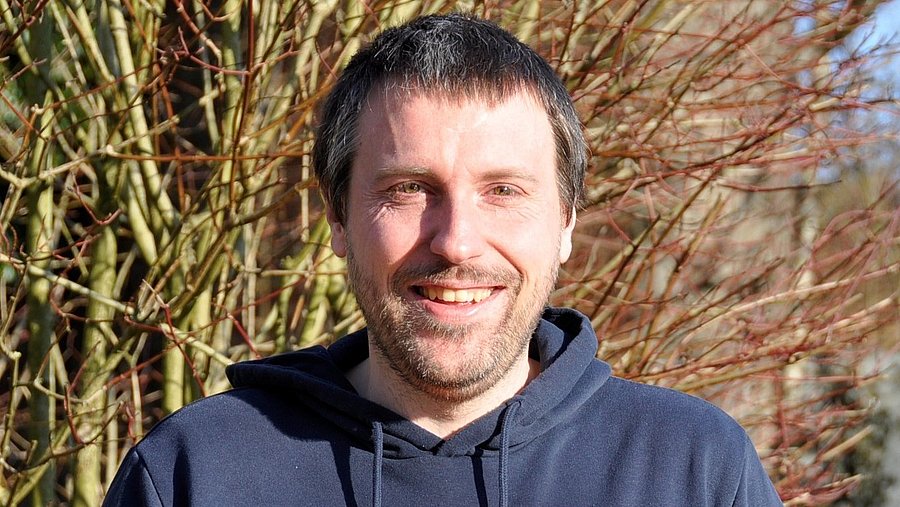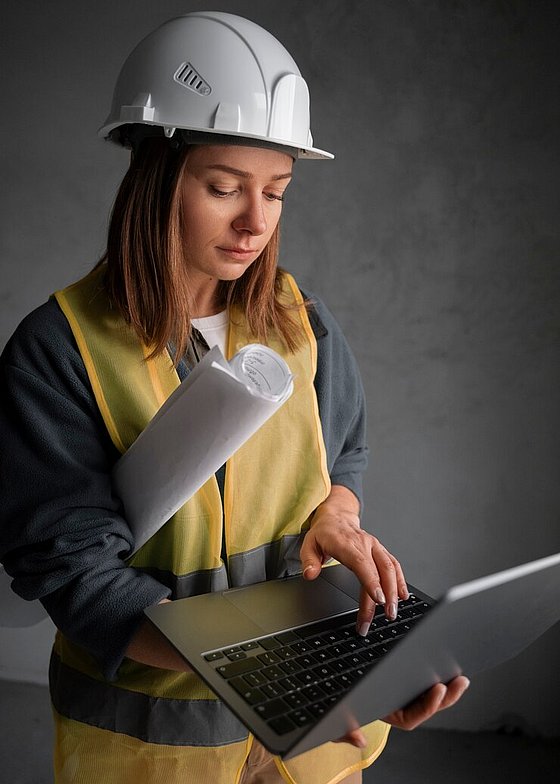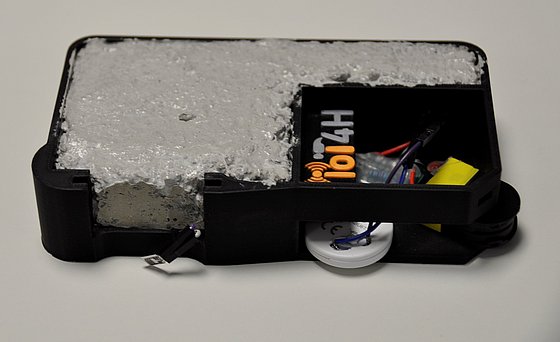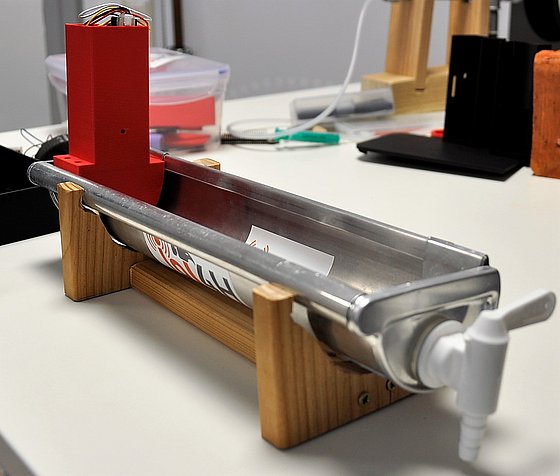
Into a digital future with the skilled trades
Dr André Pomp / Technologies and Management of Digital Transformation (TMDT) Photo: UniService Third Mission
Into a digital future with the skilled tradescrafts sector
Engineer André Pomp on the Wuppertal university project "Internet of Things for the skilled trades crafts sector (IoT4H)"
"“Digitalisation can also be efficiently and practically implemented in the skilled trades,”" says the Wuppertal-based engineer Dr André Pomp from the Chair of Technologies and Management of Digital Transformation (TMDT) at the universityUniversity of Wuppertal. He has been in charge of the "“Internet of Things for the skilled tradescrafts sector”" project, known as IoT4H for short, for three years and says,: "“We identify specific use casesapplications for the Internet of Things in the skilled trades and implement them in practice with skilled trades companies - and the potential is huge.”"
A well-known area of application for IoT: the smart home
The generic term for technical processes and systems for building automation in living spaces and homes, which focus on increasing the quality of living, security and efficient energy use, is the smart home. "“If you want to control your light via your mobile phone, for example, that's a typical use caseapplication, the so-called smart light bulb,”" explains Pomp. Automated heating control at home can also be switched on and off as required using small, smart thermostats and a room sensor. In this way, the heating can preheat a room while the person people isare still on their way home. "“Today, we even have smart fridges and dishwashers. So in many everyday objects that can somehow be made intelligent with sensors and actuators (actuators are drive elements that transform electrical signals and current into mechanical movement or light, editor's note), that's where we find the Internet of Things.”"

Digitalisation in the skilled trades, image freepik
Skilled trades crafts businesses often lack IT specialists
The skilled trades crafts sector already utilises numerous digital tools and is constantly expanding its digital capabilities. Nevertheless, the skilled craftstrades sector faces the exciting challenge of continuing to shape the path to the digital future and fully utilising its opportunities. However, many of the companies are very small, explains the engineer and says,: "“The majority of companies have no more than five employees and this naturally means that they cannot hire specialised IT staff.”" In addition, digitalisation is not a major focus of training in the skilled trades crafts sector, meaning that both trainees apprentices and active employees have little contact with the technology on a day-to-day basis. "“We have many large manufacturers who are trying to bring IoT solutions for the skilled tradescrafts sector onto the market. However, they always have the disadvantage that the trade skilled crafts businesses pass on their data to these companies free of charge and may have to pay again later for the service developed on their data.”" Collecting the data for yourself and using it freely is simply not something that is found in the skilled crafts sector. This is where the IoT4H project can offer an opportunity by imparting skills, making the skilled trades aware of the many digital possibilities and, for the first time, offering a platform whose collected data belongs solely to the skilled tradespeople.
IoT4H - The digital portal for the skilled trades crafts sector
As part of the BMBF programme "”Innovations for tomorrow’s the production, services and work” of tomorrow", the Chair of Technologies and Management of Digital Transformation has been working on a three-year project since 2022 to develop ways of enabling skilled trades businesses to explore the potential of the Internet of Things for themselves and use it profitably. Pomp explains: "“Our credo is: from the skilled trades - for the skilled trades, because if you want to develop something for the skilled tradescrafts sector, you naturally have to take the skilled trades crafts sector with you.”" André Pomp and his team colleagues Alexander Paulus and Andreas Burgdorf therefore looked for major partners from the skilled tradesskilled crafts sector to support them and found them in the Rhein-Erft District Skilled Crafts Association and the Mittelstand-Digital Zentrum Handwerk. "“We then tried to get companies in NRW North-Rhine Westphalia interested in the project, i.e. companies that would work with us to research a wide variety of their own problems within this research project, so to speak,”" says Pomp says, explaining the next steps. "“These are companies from the fields of monument conservation, structural and civil engineering and heating construction, as well as roofers and an electrical company, of course. We are also trying to get in touch with lots of other tradespeople via hackathons (a hackathon is a short-term software and hardware development event that brings people together to solve certain real-life problems in a fair competition, editor's note) or digital workshops in order to gather further knowledge about what can actually be done with IoT in the trades. You have about 24 hours to do thissucceed. Employees from craft businesses come to us present their with a problem and we try to implement a prototype with them within this time frame.”"
Several IoT-based use cases and prototypes for the skilled tradesskilled crafts sector have already been realised as part of the project. For example, a rain gutter equipped with a sensor has been created. thatIt reports when the gutter is blocked. Prototypes for detecting moisture in screed and masonry as well as applications for tool tracking have also already been realised.
In addition to the realisation of the prototypes, the IoT4H project is creating a portal for tradescraftspeople to develop their use cases. The IoT4H portal essentially consists of two parts. The portal itself is a knowledge database. It documents IoT use cases that were identified during the course of the project. "“In some cases, we also use assembly instructions that you can reproduce yourself at home or at work, with information on what additional equipment needs to be purchased and information on which customers you might be able to sell this to in a business case, or how you can use it in your own company to optimise processes,”" says Pomp says. On the other hand, the IoT4H platform acts as a data platform. It gives trade businesses the opportunity to link the purchased solutions with the platform, collect and visualise data themselves and implement their use cases very easily. Pomp gives an example: ”If a trade business wants to offer its customers monitoring of the heating system, the IoT4H portal can be used to find suitable providers for sensor technology and information on communication. The collected data can later be processed and visualised in the IoT4H platform - a great advantage for the business, which can conveniently monitor several operating sites at the same time.”

Screed: Sensors in the screed sound the alarm if the floor is damp, photo: UniService Third Mission
Bureaucratic hurdles prevent small businesses from participating in the project
"“Initially, it wasn't difficult at all to recruit craft businesses for the project,”" says Pomp says, "the district craftsmen's association found seven companies for us relatively quickly that were really keen to take part.”" However, it was then much more difficult to keep the craft businesses in the project, as the start of the project was delayed for almost two years due to coronavirus and the flood disaster. Some companies dropped out because the order and employee situation had changed completely during this time. ButHowever, another German problem also made itself felt. "“The bureaucratic hurdles for small businesses within to join the German funding landscape programmes are very high. A crafts business with five people has the same hurdles as a large company. It is therefore often difficult to keep smaller companies onat board. This is why we unfortunately lost the small subsidised companies during the project.”"

Smart rain gutter, sensors report waterlogging, Photo: UniService Third Mission
Project promotion at trade fairs
André Pomp and his team are busy promoting their project and also regularly take part in trade fairs. “We were at the 'Zukunft Handwerk' and 'Digitalbau' trade fairs last year and there was a lot of interest. Many companies want to test the data platform,”says the engineer says, “and the chambers of skilled trades crafts and district skilled trades crafts organisations are also advising their companies accordingly.” The project will come to an end this summer and Pomp sums up: “The most important insight we have gained is that digitalisation in the skilled trades crafts sector has so far been very limited, especially in the IoT sector.” However, the potential is very high, as it was possible to identify a total of over 150 use cases across a wide range of trades in which IoT applications could potentially be used. “We should learn from our mistakes in Germany. We are excellent in research, but we are missing out on opportunities to put our research into practice. IoT and AI are just two examples of many. We want to do things differently in IoT4H,” says Pomp says. For this reason, the project team have not only set themselves the goal of submitting a follow-up application in order to continue providing scientific support for the project during the transfer phase. At the same time, Crafting Systems GmbH was founded to take on the long-term technical implementation and thus ensure a close link between scientific research and practical application. “The IoT4H portal itself , on the other hand, will of course be supported by the craft sector. We are looking for craft organisations that are keen to continue implementing this project. The Rhein-Erft and Aachen district trades organisations are already involved. The chambers of skilled crafts in Düsseldorf, Dortmund and Cologne are also supporting us.”
Further information for craft businesses on the project at https://iot4h.de/ or directly to André Pomp pomp[at]uni-wuppertal.de
Uwe Blass
Dr André Pomp works as head of the "”Semantic Systems Engineering”" research area at the Chair of Technologies and Management of Digital Transformation (TMDT) in the Faculty School of Electrical Engineering, Information Technology and Media Technology at the University of Wuppertal.
